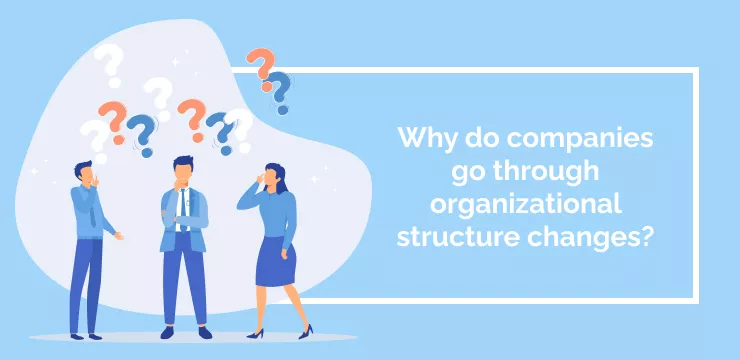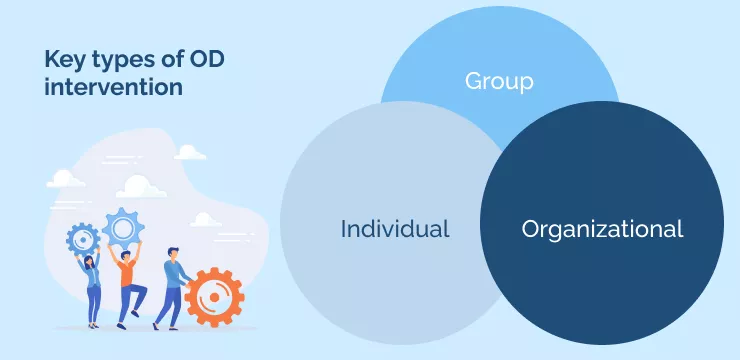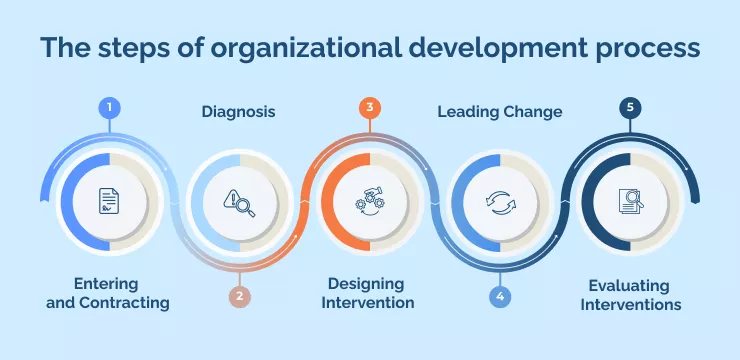
Organizational development interventions are at the heart of people-centered business innovation.
Many change management approaches are focused on top-down decision-making. A process informed by organizational development starts with the staff at the bottom. Organizational Development recognizes that staff can understand the company’s problems and solve them while working on the humanist assumption that employee performance and wellness are at the heart of organizational health and performance.
Change management deployment with organizational development relies on collaborative decision-making, where staff members at all levels of the organization work together to identify issues, develop solutions and make decisions.
Today, companies must regularly change to keep up with ever-evolving consumer demands and incorporate the rapidly advancing scope of technology. With organizational development interventions, businesses can achieve these aims within a trusting and stable environment that benefits all organization members.
After all, profits cannot come at the expense of well-being, and a 2023 Harvard Business Review article has explained how stress, flexibility, and social skills will be crucial for business development in the future.
Organizational development interventions produce incredibly positive results. This article will explain how.
What are Organizational Development Interventions?
Organizational development interventions are special projects designed to help organizations reach their goals, enhance relationships, improve effectiveness, or adapt to changes in the marketplace. An intervention should help a business to solve a specific problem and is designed to enable management and improve organizational functioning.
They might focus on organizational climate, culture, or strategies.
- Organizational climate refers to the shared perceptions and attitudes of employees toward their organization and its management. It includes factors such as communication, trust, and employee engagement. A positive organizational climate can lead to increased employee satisfaction, motivation, and performance, while a hostile environment can lead to low morale, high turnover, and poor performance. OD interventions can improve the organizational climate by addressing issues such as communication, trust, and employee engagement.
- Organizational culture refers to the underlying values, beliefs, and practices that shape an organization. It includes factors such as the organization’s mission, vision, and values, how work is performed, and how decisions are made. Organizational culture can significantly impact employee behavior, motivation, and performance. OD interventions can align an organization’s culture with its goals and values and create a culture that supports its mission and vision.
- Organizational strategies refer to an organization’s plans and actions to achieve its goals and objectives. They include both long-term and short-term plans and can be focused on areas such as growth, efficiency, and competitiveness. OD interventions can be used to help organizations develop and implement effective strategies. This may include analyzing the organization’s current situation, identifying areas for improvement, and developing plans and actions to achieve the desired outcomes.
Key types of organizational development intervention
OD Interventions come in many different shapes and sizes. But they can be broadly divided into the scale of group, individual, and organizational development interventions. There is also a wide range of more specific intervention types.
Specialist change agents will be equipped to identify the type of intervention needed to be based on the current state of affairs. Organizations can then plan to eradicate issues compellingly, using careful planning and consideration to develop the right approach.
The three central OD interventions businesses may consider being group, individual, and organizational.
Group
Group interventions are designed to help large groups of people within an organization work together more effectively. These interventions can involve the whole company, or they can be focused on smaller teams or departments. They may focus on communication and collaboration, problem-solving, team building, conflict resolution, and other topics related to effective group dynamics.
Individual
Individual OD interventions are designed to help individual employees or teams within an organization work more effectively. These interventions may focus on personal development and growth, communication skills, conflict resolution, problem-solving techniques, career planning, and other topics related to effective individual functioning.
Organizational
These interventions focus on organizational systems and structures, such as mission and vision statements, organizational values and culture, decision-making processes, job design and structure, performance management systems, communication strategies, strategic planning initiatives, information technology infrastructure design, and resource allocation approaches.
In addition to these broad categories, there are also numerous further types of intervention:
- Process Consultation – This intervention involves working with a group of people to help them understand how they interact and make decisions together, as well as helping them to find solutions to any issues they face when working in a team environment.
- Team Building – This type of intervention is used to improve the functioning of teams within an organization. It can involve activities designed to build trust, encourage collaboration, and help the team assess their communication dynamics and how they handle tasks.
- Action Research – This type of intervention involves engaging in a series of research studies to understand the causes and effects of different business issues within an organization.
- Human process interventions – A human process intervention is used to help employees gain insight into their attitudes and behaviors and how they interact. It can involve self-assessment activities, feedback sessions, and reflective exercises.
- Survey Feedback – This type of intervention involves collecting employee data about their working environment and then providing the results.
- Human resource management interventions – This type of intervention is used to identify, recruit, and retain the best talent for a company. It can involve job analysis, selection processes, training, and development programs.
- Structural Interventions – This intervention is used to make structural organizational changes, such as reorganizing teams or departments or changing reporting structures.
- Strategic Interventions – This type of intervention is used to help organizations develop strategies for achieving their goals and objectives, such as developing new products or services, exploring new markets, or changing communication protocols.
- Culture Change Interventions – This type of intervention is used to identify and address any issues within the organizational culture that might be preventing the organization from achieving its goals. It can involve creating a positive work environment, enforcing ethical standards of behavior, and developing leadership capabilities.
Implementing organizational development interventions with Lewin’s Three-stage model
The field of OD was pioneered by Kurt Lewin (1890-1947). His work in psychology and sociology has had a major impact on change management theories. His three-stage organizational change model has had a wide influence in the field.
The process is especially relevant for using an OD strategy for organizational change. Anyone implementing OD interventions should try to understand the steps.
Unfreezing
This stage involves preparing the organization for change by creating a sense of urgency and helping employees to recognize the need for change. This can be done through communication, education, and other tactics that help employees to see the current situation in a new light.
Change
This stage involves implementing the change itself. This can include developing new policies, procedures, and systems and training employees on how to use them. The goal is to move the organization from its current state to the desired future state.
Refreezing
This stage consolidates the change by fully integrating it into the organization’s culture and systems. This can include reinforcing new behaviors and policies through rewards, recognition, and communication. It also involves monitoring and evaluating the change to ensure it is effective and sustainable.
Lewin’s model emphasizes that change is a process and can only be successful with proper planning, execution, and follow-up. Lewin’s model is widely used as a general guide for designing and implementing organizational change interventions. It has been applied to various organizational change efforts, including culture change, process improvement, and leadership development.
The steps of organizational development process
To implement organizational Development interventions, many change agents will find that they need more resources than Lewin’s three-step model alone. Some recommend five stages: entering and contracting; diagnosis; designing the intervention; leading change; and evaluating interventions.
Entering and Contracting
The first step in the organizational development process is entering and contracting. This is when the company recognizes the need for improvement and initiates change. It is a crucial step as it involves identifying the specific areas of the organization that require intervention and determining the goals and objectives of the development process.
This phase establishes a clear understanding of the project’s scope through communication and collaboration with key stakeholders, including management and employees. This step also includes negotiating and finalizing agreements with any external consultants or partners who will be involved in the process.
Diagnosis
Companies will then be asked to identify the root cause of the issue and how the intervention can tackle the heart of the problem. Understanding the problem is one thing, but laying down an effective solution is another story altogether.
Designing Intervention
Here the magic truly begins to happen. Companies will design an approach to tackle the issue at hand or intervene as means to proactively fix things.
Your strategy will generate value for your business, helping you transition into new methodologies and mindsets.
Leading Change
When your intervention is ready, it must be managed accordingly. If introduced without the structure needed, change can cause chaos resulting from undesired consequences.
Instead, you should establish a focus group who become advocates of change. They will promote the benefits of change, introducing a structured program to be supported from the top down.
To strengthen the relationships of your focus group, you’d be wise to engage them with some exciting change management exercises.
Evaluating Interventions
Evaluate your course of action to learn whether your approach has been successful. You should assess whether you’ve stayed on track and tweak your approach according to measured results.
You might need to redesign your approach, but this is part of a continuous development philosophy.
Following these five important steps will give you a rough guideline for your intervention. Of course, your approach should be tailored to individual circumstances, understanding each case has a unique set of characteristics.
The Top 3 Benefits of Organizational Development Interventions
New strategies don’t always help, but OD interventions can introduce major positive organizational changes.
Out of the OD’s many benefits, this final section will focus on three: Communication and employee career development.
Communication
Organizational development is an excellent opportunity for employees to establish rapport.
The improvement process requires close proximity with counterparts, a great time to bond and align objectives.
The process itself is rooted in communication, feedback, and interaction. Employees will learn how to communicate with each other, which strengthens your team’s relationship.
This has various direct and indirect benefits, including increased productivity.
When the right communication is promoted, employees will better understand the need to change, as the necessity for organizational development is regularly discussed.
Organizations can foster advanced communication skills through open dialogue that proactively involves invested parties.
Employee Development
Organizational development is as much about improving staff capabilities as it is about improving business operations.
Staff is, after all, the most important asset, especially since they’re responsible for driving new initiatives.
Organizational development involves influencing your team while equipping them with the skills they need to be successful in constantly changing markets.
This could involve anything from bringing them up to speed with modern technology, to familiarizing them with practical and effective change management tools.
Companies must regularly educate employees to speed up the latest innovations. Learning, training, and skills competencies are a great way to bolster your team while promoting a continuous improvement philosophy.
Continuous Process Improvement
Businesses must commit to regular improvement if they’re to remain competitive.
Continuous improvement is a mindset that should be embraced if companies are to not only retain their current clientele but also gain new customers.
Companies must grow in alignment with external conditions. Organizational development promotes a continuous improvement cycle in which companies evaluate, plan, monitor, implement, and improve strategies.
This proactive approach to change positions companies for big achievement by leveraging change for renewal and embracing it at the core of company culture. Functions modeling change must also be in place, including resource allocation and training.
Organizational Development Interventions for Organizational Success
Research from a 2021 McKinsey survey shows clearly that “the more transformation actions a company takes, the greater its chances for success.”
Businesses can use OD interventions for many familiar situations, including the performance management process, human resource development, and other strategic change interventions. Used correctly, it can lead to sustainable transformational change for an organization, improving organizational effectiveness and stimulating ongoing improvement
It’s worth remembering that OD itself is a major field of research. And more than in other areas of business, it’s important to find support from well-qualified personnel. MBAs and Ph.D. programs worldwide bring people up to speed with the latest approaches and techniques.
As always, a third-party change agent will bring this information to the institution (at a price), creating an OD intervention strategy that internal staff could not produce themselves.
WalkMe Team
WalkMe spearheaded the Digital Adoption Platform (DAP) for associations to use the maximum capacity of their advanced resources. Utilizing man-made consciousness, AI, and context-oriented direction, WalkMe adds a powerful UI layer to raise the computerized proficiency, everything being equal.








